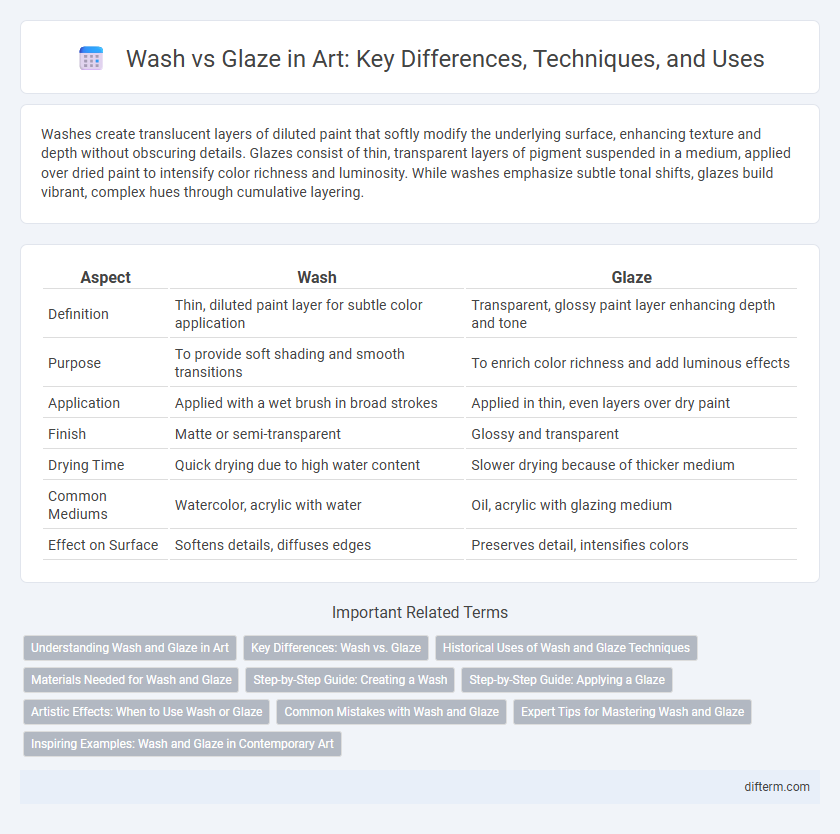Washes create translucent layers of diluted paint that softly modify the underlying surface, enhancing texture and depth without obscuring details. Glazes consist of thin, transparent layers of pigment suspended in a medium, applied over dried paint to intensify color richness and luminosity. While washes emphasize subtle tonal shifts, glazes build vibrant, complex hues through cumulative layering.
Table of Comparison
| Aspect | Wash | Glaze |
|---|---|---|
| Definition | Thin, diluted paint layer for subtle color application | Transparent, glossy paint layer enhancing depth and tone |
| Purpose | To provide soft shading and smooth transitions | To enrich color richness and add luminous effects |
| Application | Applied with a wet brush in broad strokes | Applied in thin, even layers over dry paint |
| Finish | Matte or semi-transparent | Glossy and transparent |
| Drying Time | Quick drying due to high water content | Slower drying because of thicker medium |
| Common Mediums | Watercolor, acrylic with water | Oil, acrylic with glazing medium |
| Effect on Surface | Softens details, diffuses edges | Preserves detail, intensifies colors |
Understanding Wash and Glaze in Art
Washes in art are thin, transparent layers of diluted paint or ink that create soft, subtle backgrounds or tonality, emphasizing luminosity and depth. Glazes are similarly transparent layers but are typically applied over dry paint to enrich color intensity and modify surface texture with controlled precision. Mastery of wash and glaze techniques enables artists to build complex visual effects and enhance the dimensionality and vibrancy of their work.
Key Differences: Wash vs. Glaze
A wash is a thin, transparent layer of diluted paint applied to a surface, often used to create a light tint or subtle background effect, while a glaze is a more controlled, translucent layer of paint applied over a dried layer to enrich color and enhance depth. Washes tend to be more fluid and cover larger areas quickly with less precision, whereas glazes require careful application to build up luminosity and color complexity without obscuring underlying details. Key differences include the level of opacity, application technique, and the intended visual impact on texture and color vibrancy in artworks.
Historical Uses of Wash and Glaze Techniques
Wash and glaze techniques have been integral to art history, with washes dating back to ancient Chinese ink paintings where diluted pigments created soft, atmospheric effects. Glazing became prominent during the Renaissance, particularly in oil painting, as artists like Leonardo da Vinci layered transparent glazes to achieve depth and luminosity. Both methods have evolved but continue to influence contemporary art by enhancing texture, tone, and visual complexity.
Materials Needed for Wash and Glaze
Creating a wash in painting requires diluted pigment mixed primarily with water or a solvent to achieve transparency, often using brushes and palettes for application. Glazing demands multiple layers of thin, transparent paint combined with a glazing medium such as linseed oil or acrylic medium to enhance color depth and luminosity. Essential materials for both techniques include high-quality pigments, suitable brushes, and appropriate binders or mediums to control consistency and drying times.
Step-by-Step Guide: Creating a Wash
Creating a wash involves diluting paint with water or medium to achieve a translucent layer that enhances depth and luminosity in artwork. Begin by selecting a base color and mixing it with sufficient water to form a transparent consistency, then apply it evenly using a soft brush over the surface. Allow the wash to dry completely before adding subsequent layers or details to prevent blending and maintain clarity in the painting.
Step-by-Step Guide: Applying a Glaze
Applying a glaze involves first preparing a smooth, clean surface on the artwork to ensure even adhesion. Next, mix the glaze medium with transparent paint pigments to achieve the desired translucency and color depth. Finally, use soft brushes to apply thin, uniform layers of glaze, allowing each layer to dry fully before adding the next to build rich, luminous effects.
Artistic Effects: When to Use Wash or Glaze
Wash creates translucent layers of diluted pigment, ideal for establishing broad tonal values and soft backgrounds in watercolor paintings. Glaze involves applying thin, transparent layers over dry paint to enrich color depth and enhance luminosity, perfect for refining details and adding subtle shadows. Artists choose wash for initial atmospheric effects and glaze for building complex color interactions and highlights.
Common Mistakes with Wash and Glaze
Common mistakes with wash and glaze in art include using washes that are too thick, resulting in a loss of translucency and uneven layering. Artists often confuse glazing with wash, applying overly saturated colors that obscure underlying details instead of enhancing depth and luminosity. Failing to allow adequate drying time between layers can cause blending and muddying, compromising the clarity and vibrancy of the artwork.
Expert Tips for Mastering Wash and Glaze
Expert tips for mastering wash and glaze techniques in art emphasize controlling pigment dilution and layering for desired transparency. Use a thin, even wash to create smooth color gradients and subtle backgrounds, while applying glaze in multiple layers enhances depth and richness by allowing light to reflect through the semi-transparent paint. Mastery involves patience, proper brush selection, and understanding drying times to prevent lifting or muddiness in the final artwork.
Inspiring Examples: Wash and Glaze in Contemporary Art
Wash and glaze techniques offer distinct effects in contemporary art, with washes creating translucent layers of diluted pigment that evoke ethereal depth and mood, while glazes provide rich, glossy surfaces through thin, transparent paint applications enhancing color vibrancy and texture. Artists like Mark Rothko employ washes to generate atmospheric fields of color, whereas Gerhard Richter's glazes achieve luminous, multi-layered surfaces that captivate viewers. These methods exemplify innovative uses of transparency and layering, pushing boundaries in abstract expressionism and photorealism.
wash vs glaze Infographic

 difterm.com
difterm.com